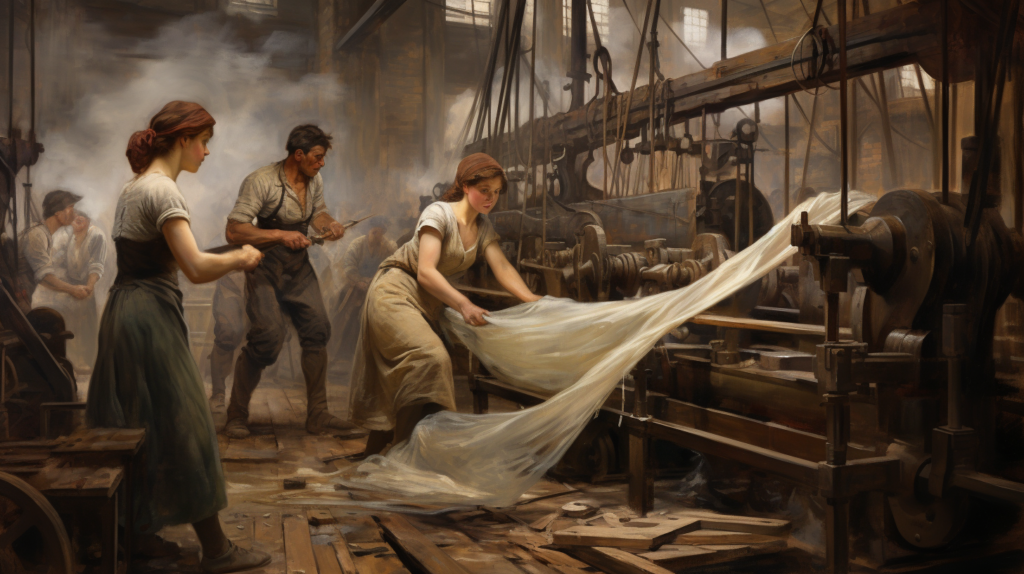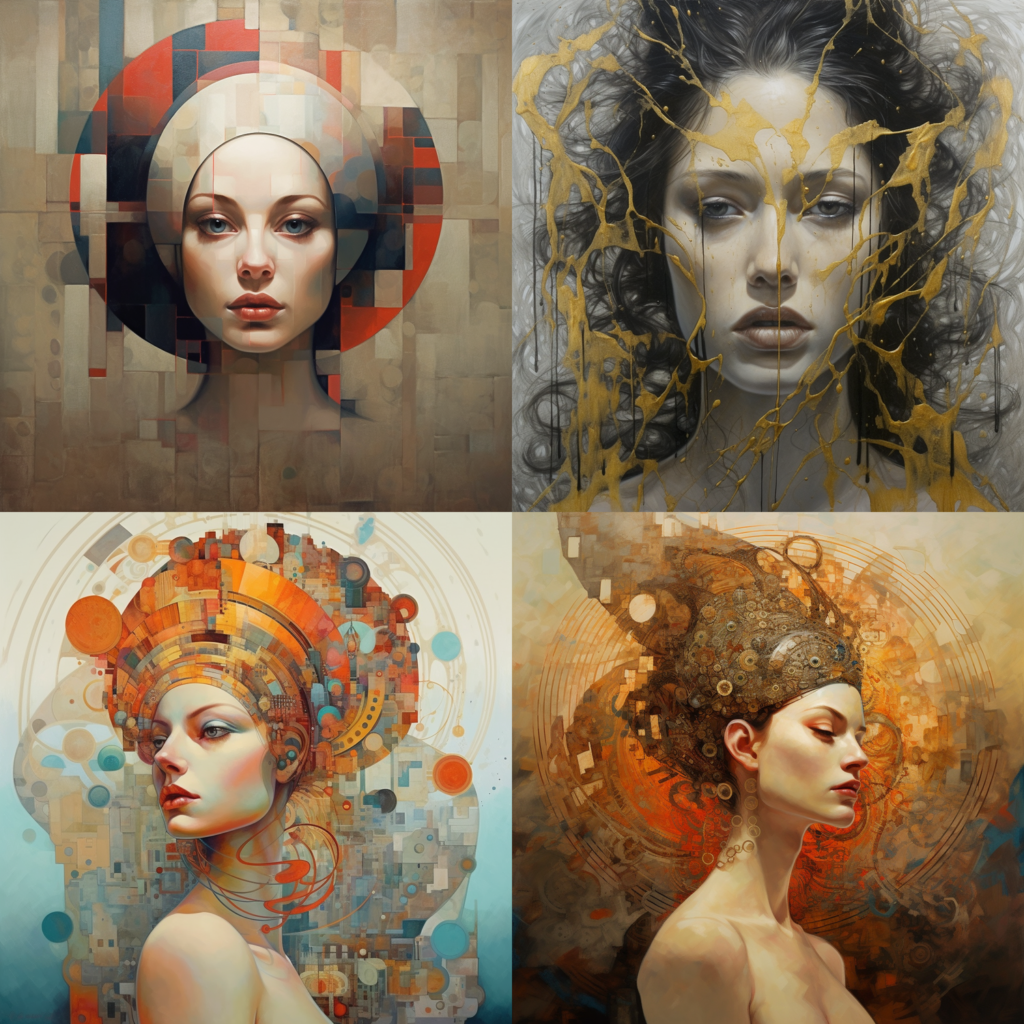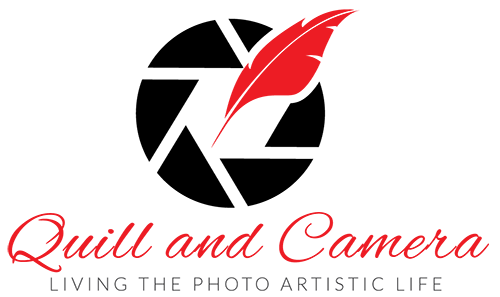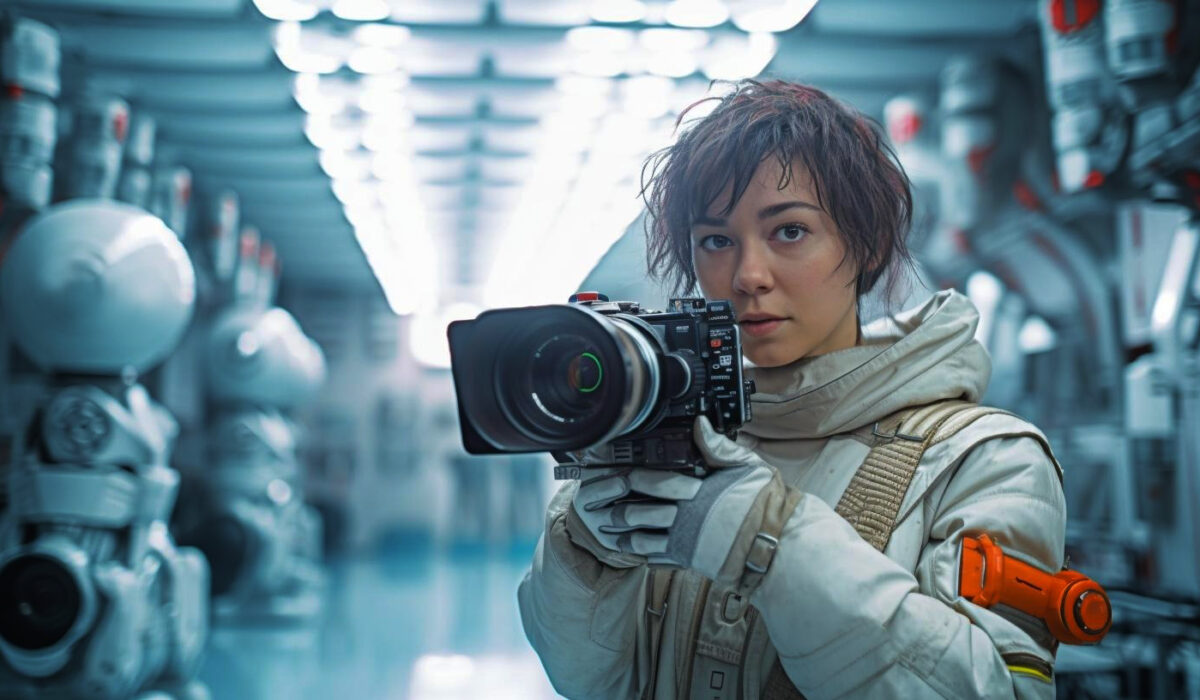— guest post by Phil Steele
Controversy has surrounded every man-machine collaboration throughout history.
Luddites smashed mechanical weaving looms in 19th Century Britain, fearing that the machines would displace hand weavers (which, of course, they did).

Fears of robots, automation, and computers-run-amok have attended every major advance in digital technology since the 1950s.

Today this trend manifests in the fear that Generative Artificial Intelligence threatens human artists and knowledge workers. ChatGPT seems poised to take over the jobs of lawyers, psychotherapists, and even novelists. And the image-making engines like Midjourney and DALL-E are said, by some critics, to threaten the livelihoods of all visual artists.
There is even a class-action lawsuit against Midjourney and several other image-making AI companies, claiming that these machines engage in copyright infringement and artistic theft. I’ll explain below why I think these claims are ill-founded and destined to fail in court.
But first, let’s take a look at the broader ethical issues surrounding generative AI.
We need to consider not just the impact of machine-automation on jobs and machine learning on intellectual property, but more fundamentally how we, as creators, can ethically represent the work we create with these systems.
1. Honest Attribution
It should go without saying that you should never misrepresent the way you created an image.
If you made an image in Midjourney, you should always say so. To pass it off (even implicitly, by posting it without comment) as something you photographed with a camera or made somehow by hand would be an act of artistic fraud.
So let’s stipulate that anything you create in a text-to-image AI like Midjourney should have an appropriate caption or explanation. Given that these works are a collaboration between human and machine, I think it’s appropriate to credit both, for example a heading like “Imagines I created in Midjourney” or a caption like “Phil Steele via Midjourney.”
2. Don’t Overestimate Your Own Contribution
How much credit do you deserve for creating an image in Midjourney?
Some small fraction of the credit belongs to you, the human who writes a text prompt to tell the machine what to “imagine.”
A much larger fraction of the credit belongs to Midjourney, which is actually a fuzzy constellation of entities consisting of:
- The computer scientists on the Midjourney team.
- The countless laborers who keyword-tagged the billions of images that Midjourney was trained on.
- The other Midjourney users who provide the human feedback that improves its performance.
- The millions of artists whose work has been “studied” by Midjourney during its training.
I usually feel that my credit in the collaboration amounts to something well below half, sometimes near zero.
For example, if I type a one-word prompt like “woman” and Midjourney gives me a gorgeous work of art, do I deserve even 1% of the credit? Maybe 0.01%? Do I get some bonus credit for going through the ridiculous sign-up process required to create a Midjourney account? (I think so).

On the other hand, if I slave over a prompt for hours, refining and fine-tuning it, studying the Midjourney documentation to tweak parameters like Chaos and Style, and through my extensive knowledge of art history, I manage to finally create the unique work I envisioned—well, then I may feel like my share rises to something approaching (but never quite reaching) 50%.
In short, we are the junior partners in this collaboration, and we should never forget it. I imagine it’s a bit like the way Art Garfunkel probably felt—I’m really happy to be involved in this joint venture, but I know who the real artistic genius is here.
A few of my subscribers have complained that they can’t copyright the work they produce in Midjourney. I wouldn’t dream of claiming this work as my own. Exactly who, or what, should get the bulk of the credit is not quite clear, but I know it’s not me.
3. If this is image theft, then every human artist is a thief
The claim that art-generating AI somehow “steals” copyrighted images results from a fundamental misunderstanding of how these systems work.
For example, the infamous copyright-infringement lawsuit against these AI companies gets the technological facts embarrassingly wrong, and I suspect it will be quickly dismissed or settled as a result.
That lawsuit claims that the AI engines store “internal copies” of the billions of images in the training data (which would be technologically impossible, too much data), and that the AI literally takes pieces of those images to create a “collage” in the output images.
Anyone who has used one of these engines for more than a few minutes would recognize this claim as preposterous. The results are nothing like a collage—and quite often like nothing that has ever existed before.
Here’s how it really works. The neural network starts out blank (tabula rasa as the Romans used to say), much like a human infant does. The network is then “shown” images by allowing it to follow hyperlinks to billions of images, each link typically containing a description of the image, with details like the artist’s name, the style, and the content of the image, etc. The internet contains billions of these links and images, and after looking at a few billion, the neural net begins to understand art, in the same way a human being starts to understand art after looking at lots of examples.
The AI does not make internal copies of the images. Instead, it learns abstract principles, which it encodes in mathematical form in its neural net, principles about light, and color, and beauty, and style. It learns what a dog is, and a cat, and a mountain, and an ocean—not some particular dog from its training data, but an abstraction based on all the dogs in its training data.
This is exactly how all human artists learn.
Human artists also start out tabula rasa. Then, over a lifetime of studying art—or perhaps over a college career in art history, or merely a weekend class in landscape painting—they learn some things about art by observing art created by others. They remember some parts of it in detail, but more importantly, they form abstractions and general principles about how art works and what looks good.
In short, humans and AI systems “learn” in very similar ways.
But when humans then go on to create new art based on what they have learned from studying past art, they are not typically accused of copyright infringement (though sometimes they are).
To accuse these AI systems of “stealing” from the training data is to fundamentally misunderstand how they work—and to fundamentally misunderstand their similarity to human artists.
I actually believe that the generative AI systems are far less likely to copy other artists’ work than humans are.
First of all, we know that humans frequently copy other people’s art, both intentionally and unintentionally. How many times have you thought up a great melody only to discover that John Lennon wrote it 50 years ago? Or had an “original” idea for a photo only to discover that you’ve recreated a famous shot by Dorothea Lange that you forgot you had seen dozens of times.
Humans make this kind of mistake, machines don’t.
Unlike a human, an AI can be programmed to never literally copy any of its source material (even if it had the source material available internally to copy, which it doesn’t). Of course, we are trusting the programmers of the systems to get this part right, to never let the machine reproduce anything that it was trained on. The programmers take this very seriously (lawsuits are expensive), and I think we can assume the machines are therefore better at avoiding plagiarism than most humans are.
Also consider: These machines are trained on billions of images. How many images has the typical human artist usually learned their “style” from? A handful? A few dozen? I’ve seen human painters and photographers whose influences are so obvious that you can barely tell their work from the artist who they are taking “inspiration” from. “Oh, he’s just imitating Salvador Dali.” We may accuse these artists of unoriginality, but we don’t accuse them of copyright infringement or “theft”—because a style is not something that is copyrightable.
So which one is more likely to adhere too closely to a particular artist’s style: A machine that was trained on billions of images, or a human artist trained on a few artists’—or perhaps even a single teacher’s—style?
For all of these reasons, I think the hand-wringing over generative AI “stealing” from human artists is misguided, and I think the courts will soon agree.
4. Citing Living Artists
There is one area where I think AI-generated art presents a genuine ethical dilemma.
When writing a text prompt for a generative AI like Midjourney, one can call for a particular artist’s style by name. For example you might say “in the style of Rembrandt” or “in the style of Ansel Adams” or even call for multiple artists like, “Picasso, Monet, Van Gogh.”
In the case of Midjourney (which is the only AI engine that I have used extensively enough to comment on), the results of these requests can vary from being extremely true-to-source, so that any knowledgeable viewer might say, “That looks like a Van Gogh,” to being only vaguely influenced in ways that are almost undetectable.

I created the synthetic photo above with the prompt “lifestyle photo of young women in Grecian tunics lounging in bright outdoors classical setting, in the style of alma-tadema, Hasselblad X1D –ar 16:9.” Have I harmed the memory of Alma-Tadema with this? I don’t think so. His influence may be present in the styling or posture of the women, perhaps, but if so, it’s subtle, and Alma-Tadema was not working with a Hasselblad, or modern models, or a modern color palette, let alone in the medium of photography.
The obviousness of the influence depends largely on how unique the source artist’s style was—it’s easy to spot the influence of Van Gogh, or Andy Warhol, or a photographer like David LaChapelle, because their work is unique and easily identifiable. It’s much harder to recognize the influence of artists whose works were part of a broad stylistic movement, like the many artists in the impressionist school, or the manga illustration styles of today, or the countless commercial photographers whose works are more mainstream.
The possible ethical question that arises is: If I cite the style of a living artist, am I possibly “taking work away” from that artist?
One can think of examples where this might be true. Let’s say I’m the art director at a Vanity Fair magazine, and I ask Midjourney to create me a fashion photo “in the style of Annie Leibovitz” which I then use in the magazine instead of hiring Annie Leibovitz to take the photo.
In that case, you might say the Art Director “took work away” from Leibovitz by using the AI photo instead, because this is a case where a commercial magazine, with the budget to hire Leibovitz, could have actually hired her to do the job.
Similarly, there are countless commercial illustrators who make their living producing work for magazines or other media, who could rightly object if an editor created an illustration “in the style of illustrator x” from an AI engine instead of actually hiring illustrator x to do the job.
To me, this concern only seems to arise when two conditions are met, (a) the artist is alive and still working, and (b) it’s a commercial media job where there is actually a budget to hire such work.
In all other conditions, I don’t think this concern really applies, as in the kind of work most of us do, where we are creating images for our own pleasure, or possibly for sharing online for free, with no commercial implications. When you or I say “in the style of artist x” and share the result on Instagram, we were never going to hire artist x in the first place, so we haven’t taken a job away from them.
But I’m still a bit uncomfortable citing the name of just one living artist or photographer in my prompts. I prefer using a combination of artists (“in the style of x, y, and z”), or citing only historical artists who are no longer working.
For now I see this ethical issue existing on a sliding scale, depending on how you intend to use the images you create:
Q. Is it ethical to cite living artists to influence the style of an image?
- Images for personal pleasure — No concern
- Images for sharing with friends — Small concern
- Images for non-commercial publication — Moderate concern
- Images for commercial publication — To be avoided. Hire the artist.
This is a question I’m still wrestling with, as I become more familiar with how much the style of a cited artist actually influences the final work. I intend to revisit this question as I experiment more and as the AI systems evolve. I’ll write more on this in the future.
.
If you haven’t yet checked out Phil’s new Synthetic Photography Masterclass on using Midjourney to generate models (and an infinite array of animals, backgrounds, special effects, and other elements) for use in your photo artistry . . . click here and have a look!

